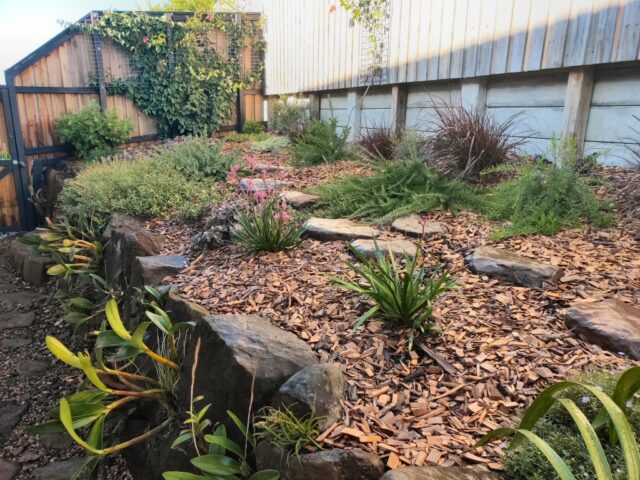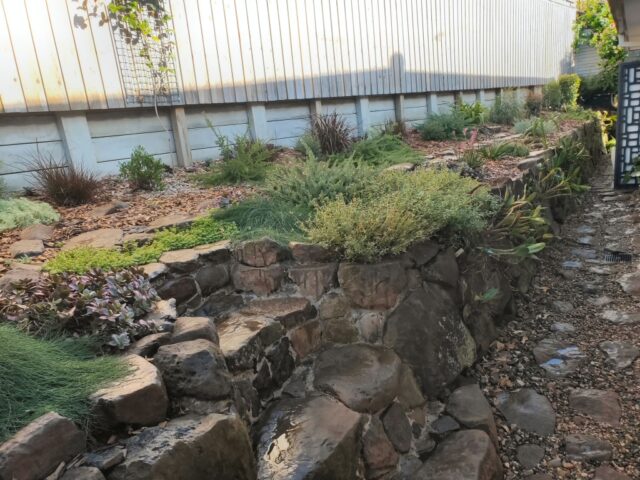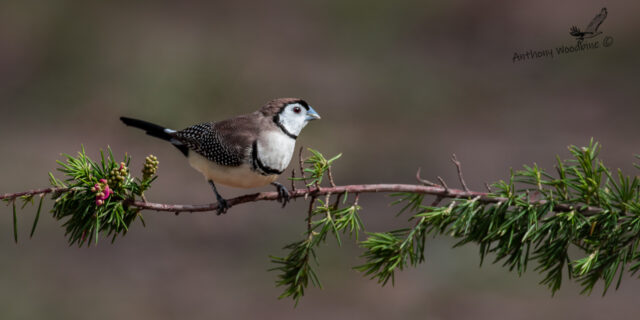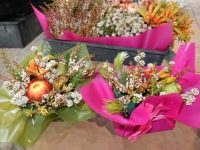Creating an Australian Native Garden Using Tube Stock
Have a look at this garden, which is being purposefully created to be a refuge for smaller birds, away from the larger more aggressive birds that also frequent their garden. A habitat within a habitat!
It was a bare blank canvas a short 5 months ago, then planted up with various tube sized plants- read on for more, as it is inspirational!
When planning a new garden, or upgrading and adding to an existing one, we usually have a vision of what we want the end result to look like. People may see a small plant in a tube and find it hard to see how this small plant will grow to become the well established large version. This can lead people to buying bigger plants for their gardens, thus creating that ‘instant garden’ feel. The larger plant in a pot has had many hours of care in the nursery, and will inevitably cost more, and so it should…..nursery people need to eat too! But there are some good benefits of planting tube stock, not the least being that they are a very cost effective way to buy plants. Comparing well established plants in larger pots, to tube stock, you will get many more plants for the same price as one big one. The cheaper price lets you try plants you might not otherwise consider, as the loss of an experimental planting is not so keenly felt. It is a very good feeling when you do take a punt on a plant that you think may not work, only to find it does find your garden to its liking.
Tube stock also has the advantage of being a more portable item. Plants can be sent via courier or posted in the mail more cheaply than larger ones, which is a great option for those who love online shopping, or do not live near a native plant nursery. This can also make it easier to get plants that may not otherwise be available and also opens up opportunities to source plants that may sometimes be hard to find (such as Tall and Tough Kangaroo Paws). Nurseries are also a good source, the native plant specialists in my nursery directory always have good stock, and helpful information.
From my experience, planting tube stock into the garden allows the plant to develop a better root system. Plants often resent being repotted, so planting straight from a tube into the final position lets the root system power away with no setback from root disturbance in the repotting process. Plants that have been in larger pots can become accustomed to the conditions of the pot. They get used to being watered frequently, they rely on regular feeding and their root systems are limited to the space of the pot. Confining roots in this way for long periods of time can cause the roots to bunch up in a mass of twists and turns, and can sometimes even leave the plant pot bound. A pot bound plant can be difficult to remove, but the real problem is that once the roots have curled around and become established in the pot shape, it seems to be difficult for healthy strong root systems to develop further. This is often most evident in woodier plants, and these are the ones that need a supportive root structure. Certainly shopping at better nurseries will lessen the problem of pot bound plants though, as good nursery people will ensure that plants get sold or potted up before this happens.
One last benefit of tube plants is that they take a bit more care in the early stages to get them established, and this can often make you just that bit more attached to your plant. All that nurturing will lead to lasting gardener-plant bonding, and will definitely help develop those green thumbs!
I wanted to share with you all a tube stock success story that one of my customers was kind enough to share with me. They had moved out of their family home, where they had spent the last 35 years creating a tropical garden paradise, and into a house where the garden needed to be built from scratch. With the new garden, they had a vision of creating a low dense flowering corridor at the side of their house that the small birds can use safely without being attacked by the local butcher birds, currawongs and noisy miners. They ordered some tube stock from my website and when it arrived, I received this great feedback:
“The plants arrived yesterday morning in good condition. They are now happily planted out in our new native suburban garden. They look tiny in their position but they will soon take off and hopefully be perfect for the tough position that they have been planted in. A bit of hot and windy weather up here at the moment but we will baby them for a while until they are established. We will let you know how things go.”
I like how they pointed out that the plants look tiny in their position. As mentioned before, some people may question whether buying tube stock is a good idea for this very reason. When first planted out, the plants can look small in the garden setting, but as we will go on to see with the example of this customer’s garden, with proper care, tube stock do not take long to grow and establish. The customer went on to share:
“We have bought tube stock before so there were no unexpected surprises as I could immediately see how healthy your plants were and they now are all doing nicely here considering the intense heat wave that we had when they first arrived. We are working on a clean slate this time and so different to the mature garden that we left behind us, so we are really keen to see what we can create. Interestingly we had also planted a lot of tube stock there and they have handled most of the situations that we planted them in quite well.”
Five months later, I received another email from the customer and it was more positive feedback with some really interesting information about how the plants faired during very hot weather. They said:
“Just an update on how the plants are going. Five months have passed and they all are thriving. We have had some rain recently but have just endured five months of punishing hot and dry weather. This whole section of garden has only been planted in the last five months, not one plant in this whole area before,as you can see they are doing well and it is coming together nicely. The rock wall was there when we moved here but had none of the native orchids planted on it, they also have only been there for five months. We had a significant number of orchids in pots that we had from a previous collection that we had brought with us. We have set them all free on the wall and they are thriving with very little establishment problems and will quite happily look after their own needs from here on. I do thank you again for your beautiful healthy plants that you sent us. We now have the front gardens to renovate into a similar theme of hardy low growing natives and we will be needing more plants. We will happily be buying more from you.”
I was so happy to receive this testimony and the pictures to go with it. Like the customer, I too was impressed with the growth of the plants. We emailed back and asked if they had given the tube stock any extra care over the last five months and this is what they replied:
“As far as fertiliser goes, we are on Red basalt soil and that is what we started with, bare red dirt. We then went to our local compost producing complex that turns all of our area’s green waste into compost and purchased about two cubic meters. We spread that to about 50 mm thick over the top which we lightly raked in with a long handled three pronged scarifier. We then used fresh Cypress chips as a top surface mulch. That was it for the soil preparation. When we plant out we water the new plants in well and straight afterward give each plant a litre of worm juice. I believe this really gives the little plants a huge boost and introduces beneficial bacteria into the root zone. Doing it straight after the initial watering in it really gets the worm juice down deep into the earth and roots. That is all we have done so far, if we get more regular rain now we will not water much but if it gets dry again we will water the new plants once a fortnight going into Autumn. Wet feet is never good when the weather cools down.”
It is no secret that I am a huge advocate of composting and worm farming. Not only for the environmental benefits, but also for what it can do for your garden. Adding compost to existing soil when putting new plants into the ground creates a nutrient rich foundation, encouraging good growing conditions for the new root system. I did like how they say that after the initial watering in of the new plants, they gave each one about a litre of worm tea. Compost and worm tea are full of beneficial microorganisms, and in my experience is one of the best ways to give your plants a boost. If you would like any tips about harvesting worm castings and/or worm tea and compost, follow my Instagram account (@gardeningwithangus) or my Public Figure facebook profile (Angus Stewart), where I have made lots of detailed posts about this topic and continue to share my ongoing composting and worm farm findings.
I was very grateful to this customer for sharing their personal testimony not only about the success of their tube stock and the methods they used to get them thriving, but further conversations that lead to Australian native wildlife conservation. Quite often, passion for Australian native plants also goes hand in hand with wildlife conservation. When we plant Australian natives into our gardens, whether it be for our own pleasure or to create habitat, we are inevitably giving our local wildlife a helping hand. This particular customer has a strong interest in native bird life and wanted to create a native, low dense heavy flowering corridor that the small birds can use safely. I have included some of his magnificent bird photographs to showcase the beauty of some of our native bird species, which will hopefully help to inspire conservation. The customer shared:
“I believe that not only are individual island type gardens beneficial but corridors linking all of these islands together is the key if we want to protect our precious wildlife. In suburban areas these islands are made up of the individual gardens and the corridors are the whole suburban areas with gardens that are all linked together as one.
I do a lot of wildlife photography around different parts of Australia. Bird photography is my specialty and have found that where there are healthy corridors this is where you find the most variety of all species including plants, birds and animals.
In NSW we are lucky to have a huge networks of TSR’s ‘ Travelling Stock Routes.’ These are not used as they were intended much for stock these days but have become very valuable wildlife corridors that have largely not been cleared and have small dams in them that were dug many years ago for travelling stock to use. The wildlife thrive along these routes largely undisturbed by modern life. Unfortunately these corridors are under threat of being sold off by the NSW government. I am hoping someone sees the potential tragedy of that decision on all our Fauna and Flora.”
Australia is home to some of the most incredible plant and animal life that is definitely worth preserving and nurturing where we can. I had so much inspiration about this subject in my childhood, with many hours spent in Sydney Sandstone country where I grew up, and my grandmother being a passionate advocate. My grandmother was a botanical artist, and also a member of the Field Naturalists of Victoria, and summer holiday visits invariably featured slide nights of native plants and beautiful bush areas. Viewing pictures from the Travelling Stock Routes felt like a continuation of this!
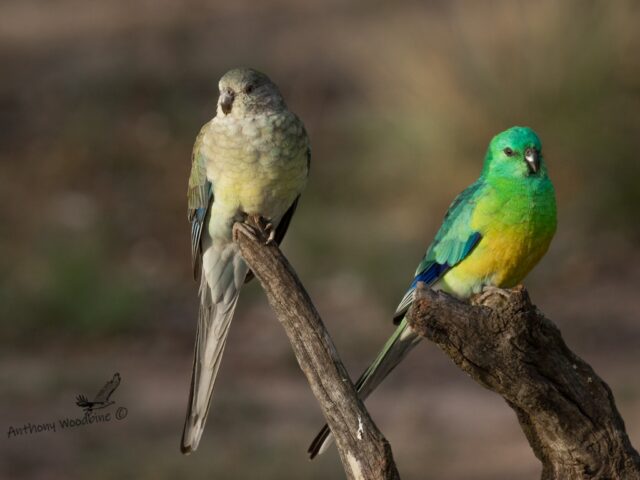
Our gardens have the potential to be an oasis for us on an individual level, and also for a vast array of native life forms. I was interested to learn about the Travelling Stock Routes in NSW and Queensland, but also saddened to hear that a number of them might be under threat in NSW. However, we can use emotions such as these to spur on action. It’s worth analysing what we can do on an individual level, just as this customer has done with their inspirational garden, bird photography and videos. I’m a big believer in taking action, so I hope that people will contact the new minister for the environment in NSW, Matthew Kean, to let him know how important the TSRs are. The address is The Hon. Matt Kean MP GPO Box 5341 SYDNEY NSW 2001. Explore the Field Naturalists too, with groups in all states, and there is also a Junior group for kids aged 6 to 14 in SA. But closer to home, even the smallest garden can have plants that benefit our wildlife….every little piece will add up to a bigger picture.
It also helps that as time goes on, native plants are becoming more readily available. The customer commented:
“The variety of small growing native plants are sensational these days compared to the limited species that were available only a few years ago.”
As awareness of Australian native plants grows and demand becomes higher, many horticulturalists (including myself) have dedicated their lives to breeding, refining and making available a wide range of incredible Australian native plants. With the internet now being such a big part of everyday life it has opened up more opportunities to gather information and also source a wide range of plants that otherwise might not have been available. Searching on the internet, you can find a lot of information about Australian native plants and also where they might be purchased. It really has opened up a whole new avenue of research and this was one of my motivating reasons behind creating my website “Gardening With Angus.” I wanted to bring awareness of new cultivars and old favourites of native plants, plus information about how and where they will work in as easy a way as possible – Australia is such a big place with such a variety of climate conditions and soil types. It is a work in progress, and I’m finding that the associated social media presence is bringing extra wonderful benefits as clever people also share their knowledge and experience.
Not much beats personal testimonies with both success and failure stories to gain more insight about a particular topic. Much of what we know about Australian native plants has been learned from science, but also from people’s own personal experiences with growing them. ‘Gardening With Angus’ is a gardening community of like minded people, all sharing their thoughts and experiences and it is my hope that this will continue to grow and build as time goes on. We can all learn so much from one another.
Gardeners really are the best people!
Don’t Forget-
Mothers Day, Sunday the 12th May. Give mums lots of love! And maybe a bunch of Australian wildflowers, or a living plant for her garden.
Flower arrangements from The Wildflower Place, Erina

